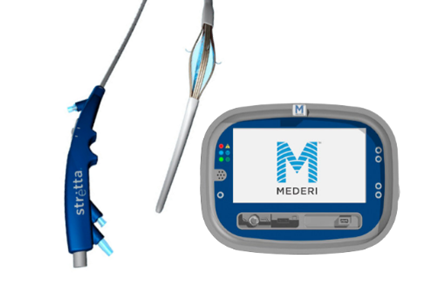Stretta Therapies Mederi™
| Stretta® | Therapies(Mederi) |
Stretta™ and Secca™ treatments fill the gap between first-line therapy and expensive and invasive treatments with higher complication rates. • Reducing system-wide costs with lower initial costs and better long-term results • Facilitating outpatient procedures Stretta™ and Secca™ are endoluminal procedures and therefore don’t require incisions, or cause scars and don't necessitate hospital stays, thus allowing for a rapid return to normal activities.
The trans-oral Stretta™ catheter system uses a proprietary application of RF energy that is low-power (5 Watts) and generates low temperatures (65°C to 85°C) during a series of 14 one-minute cycles which remodel the lower esophageal sphincter (LES) muscle and gastric cardia. The FDA originally cleared Stretta for use in 2000 and issued an updated clearance on the RF1 generator in 2011. Clinical studies demonstrate that Stretta™ RF treatment results in significant reductions in tissue compliance and transient LES relaxations, as well as increased LES wall thickness due to muscle growth. These mechanisms restore the natural barrier function of the LES and reduce spontaneous regurgitation caused by transient relaxations of the sphincter, two of the leading causes of GERD. Stretta™ is typically performed on an outpatient basis with conscious sedation.
SAGES CSR Guideline gives Stretta™ strongest Grade recommendation.
Quality of Evidence: (++++)
Grade Recommendation: Strong
The Society of American Gastrointestinal and Endoscopic Surgeons recently issued Clinical Guidelines that gave Stretta therapy for the treatment of GERD the highest GRADE recommendation. The SAGES Clinical Spotlight Review involved an in-depth analysis of available peer-reviewed clinical evidence, focusing on randomized, controlled studies, as well as long-term follow up showing durability of treatment effect.
Product Description
Structure
- Different magnitudes of segmental radial force may reduce reactive hyperplasia
- Full silicone covered to prevent tissue in-growth
- Four(4) anti-migration anchors at the distal end prevent the risk of migration
- Retrieval string facilitates easy removal of stent
- Efficient radial force
- High flexibility
- Atraumatic ends
- Thermo-reactive radial force
Pre-Loaded Delivery System
- Outer sheath: Metal braided tube contributes excellent push-ability and track-ability
- Radiopaque ring at outer sheath: Shows deploying progression
- Yellow marker: Cystoscopic marker to place stent at orifice border
- Inner stent: Reinforces overall radial force
- Three (3) Radiopaque markers : Fluoroscopic markers for accurate placement. Accordance with stent loaded portion – Proximal, Center and Distal
Indications:
Benign and Malignant Urethral Obstruction
Key Resources
Clinical Reference
- Durability of Stretta Radiofrequency Treatment for GERD: Results of an 8-Year Follow-Up Luca Dughera, Gianluca Rotondano, Maria De Cento, Paola Cassolino, and Fabio Cisarò Gastroenterology Research and Practice, Volume 2014, Article ID 531907, http://dx.doi.org/10.1155/2014/531907
- Radiofrequency-based treatments for esophageal disease C. R. Subramanian, G. Triadafilopoulos. European Surgery, published online Jan 2013, DOI 10.1007/s10353-013-0243-7
- Gastroenterology Research and Practice Mark Franciosa, George Triadafilopoulos, Hiroshi Mashimo. August 2013 http://dx.doi.org/10.1155/2013/783815
- Gastroesophageal reflux in Bronchiectasis and the effect of anti-reflux treatment Zhi-Wei Hu, Zhong-Gao Wang, Yu Zhang, Ji-Min Wu, Jian-Jun Liu, Fang-Fang Lu, Guang-Chang Zhu and Wei-Tao Liang. BMC Pulmonary Medicine 2013, 13:34
- Long-term results of radiofrequency energy delivery (Stretta) for the treatment of gastroesophageal reflux disease. L. Dughera, F. Cisaro, P. Cassolino, M. DeCento. Citta della Salute e della Scienza, Torino, Italy. Poster presented at OESO 2012.
- Radiofrequency Energy Delivery To The Lower Esophageal Sphincter Reduces Esophageal Acid Exposure And Improves GERD Symptoms: A Systematic Review and Meta-Analysis. Perry K, Banerjee A, Melvin S, Surgical Laparoscopy Endoscopy and Percutaneous Techniques, August 2012; 22(4) 283-288
- A Double-Blind Sham-Controlled Study of the Effect of Radiofrequency Energy on Symptoms and Distensibility of the Gastro-Esophageal Junction in GERD Arts J, Bisschops R, Blondeau K, Farré R, Vos R, Holvoet L, Caenepeel P, Lerut A, Tack J, Am J Gastroenterol. 2012 Feb;107(2):222-30. doi: 10.1038/ajg.2011.395. Epub 2011 Nov 22.
- Improvement of clinical parameters in patients with gastroesophageal reflux disease after radiofrequency energy delivery Hai-Feng Liu, Jian-Guo Zhang, Jun Li, Xiao-Guang Chen, and Wei-An Wang. World J Gastroenterol. 2011 October 21; 17(39): 4429–4433.
- Radiofrequency treatment on respiratory symptoms due to gastroesophageal reflux disease. GAO Xiang, WANG Zhong-gao, WU Ji-min, JI Feng, ZHANG Cheng-chao, NING Ya-chan, LI Zhi-tong, HU Zhi-wei, CHEN Xiu and TIAN Shu-rui . Chin Med J 2011;124(7):1006-1009
- Endoluminal Full-Thickness Plication and Radiofrequency Treatments for GERD. An Outcomes Comparison. Louis O. Jeansonne IV, MD; Brent C. White, MD; Vien Nguyen, MD; Syed M. Jafri, BS; Vickie Swafford, RN; Mina Katchooi, DDS; Leena Khaitan, MD, PhD; S. Scott Davis, MD; C. Daniel Smith, MD; Shahriar Sedghi, MD; Edward Lin, DO. Arch Surg. 2009;144(1):19-24
- Treatment of refractory gastroesophageal reflux disease with radiofrequency energy (Stretta) in patients after Roux-en-Y gastric bypass. Mattar SG, Qureshi F, Taylor D, Schauer PR. Surg Endosc. 2006 Jun;20(6):850-4. Epub 2006 May 12.

